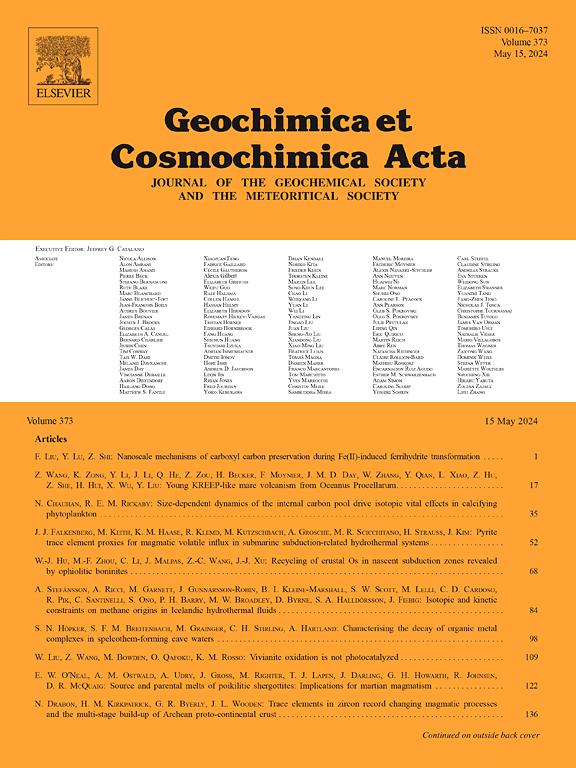Storage capacity and partitioning of sulfur during silicate melting of the Earth’s shallow upper mantle and the evolution of S/Dy during MORB-source melting
IF 5
1区 地球科学
Q1 GEOCHEMISTRY & GEOPHYSICS
引用次数: 0
Abstract
Sulfur (S) in the mantle has conventionally been assumed to be stored exclusively in accessory sulfide or sulfate phases, with the S content of primary mantle melts sourced entirely from these S-rich minerals. In contrast, recent works have argued that nominally S-free, major silicate mantle minerals such as clinopyroxene (cpx), orthopyroxene (opx), plagioclase (pl), and garnet (gt) may contain 10′s of ppm sulfur. However, the experimentally determined mineral-melt partition coefficients for sulfur (DSmin/melt) vary significantly between studies from as low as 10-3 to as high as 10-1. To contribute to this debate and to better understand the implications of the silicate mineral S-source for equilibrium mantle melting, here we present a series of new and existing silicate mineral-melt equilibria experiments with sulfur introduced to the system, and calculate the DSmin/melt for these experiments. The reported experiments span hydrous and anhydrous basaltic starting compositions with 0.04–6.08 wt% S added as sulfide or sulfate at 1.0–3.0 GPa and 1200–1350 °C. The S content of partial melts was measured using electron microprobe, while that of silicate minerals was measured using NanoSIMS. The high spatial resolution and depth profiling enabled by NanoSIMS reveals abundant S-rich hotspots throughout samples, which increase in frequency with experimental S content; we interpret these as sulfide and sulfate nano-inclusions. When hotspots are avoided, the S-carrying capacities of both sulfide- and sulfate-saturated experiments are ≤2.44 ppm for calcic cpx, ≤1.13 ppm for gt, 0.80 ppm for pl, 0.48 ppm for pigeonite (pgt), and 0.55 ppm for opx. The sulfur capacity of the sulfide- and sulfate-saturated minerals exhibits an inverse correlation with experimental temperature, but does not appear to be affected by S speciation or pressure. At sulfide-added conditions, DScpx/melt is ≤0.04190, DSgt/melt is ≤0.01081, DSpl/melt is 0.00074, DSopx/melt is 0.00039, and DSpgt/melt is 0.00034. At sulfate-added conditions, the increased solubility of S6+ in the coexisting silicate melt results in reduced partition coefficients of DScpx/melt ≤0.00105 and DSgt/melt of 0.00019. These newly calculated values are orders of magnitude lower than previously published values, a consequence of the low mineral S content measured here. Finally, we apply our new partition coefficients and those of prior work to model the evolving S/Dy during adiabatic decompression melting of a sulfide-saturated MORB-source mantle. We find that minimal partitioning of S into silicate minerals, as observed in our experiments, has negligible impact on the S/Dy of MORBs. Importantly, we also find that the S/Dy ratio of peridotite partial melts does not remain constant as a function of extent of melting; it increases and then decreases from sulfide-present to sulfide-absent conditions.
地球上浅地幔硅酸盐熔融过程中硫的储存能力和分配以及morb源熔融过程中S/Dy的演化
传统上认为,地幔中的硫(S)仅以硫化物或硫酸盐相的形式存在,而原生地幔熔体中的S含量完全来自这些富S矿物。然而,最近的研究认为,名义上不含硫的主要硅酸盐地幔矿物,如斜辉石(cpx)、正辉石(opx)、斜长石(pl)和石榴石(gt)可能含有10 ppm的硫。然而,实验确定的硫的矿物-熔体分配系数(DSmin/melt)在研究之间的差异很大,从低至10-3到高至10-1。为了促进这一争论,并更好地理解硅酸盐矿物s源对平衡地幔熔融的影响,本文提出了一系列新的和现有的在系统中引入硫的硅酸盐矿物-熔体平衡实验,并计算了这些实验的DSmin/melt。本文报道的实验涵盖了含水和无水玄武岩起始成分,0.04-6.08 wt% S作为硫化物或硫酸盐加入,温度为1.0-3.0 GPa,温度为1200-1350 °C。用电子探针测定了部分熔体的S含量,用NanoSIMS测定了硅酸盐矿物的S含量。NanoSIMS的高空间分辨率和深度剖面揭示了样品中丰富的富S热点,其频率随着实验S含量的增加而增加;我们将其解释为硫化物和硫酸盐纳米包裹体。当避免热点时,硫化物饱和和硫酸盐饱和实验的s承载能力分别为:钙cpx ≤ 2.44 ppm, gt≤1.13 ppm, pl 0.80 ppm,鸽子(pgt) 0.48 ppm, opx 0.55 ppm。硫化物和硫酸盐饱和矿物的硫容与实验温度呈负相关,但不受S形成或压力的影响。在添加硫化物条件下,DScpx/melt = ≤ 0.04190,DSgt/melt = ≤ 0.01081,DSpl/melt = 0.00074, DSopx/melt = 0.00039, DSpgt/melt = 0.00034。在添加硫酸盐的条件下,S6+在共存硅酸盐熔体中的溶解度增加,导致DScpx/melt分配系数降低 ≤ 0.00105,DSgt/melt分配系数降低0.00019。这些新计算的值比以前公布的值低几个数量级,这是由于这里测量到的矿物质S含量低的结果。最后,我们应用我们的分配系数和先前工作的分配系数来模拟硫化物饱和morb源地幔绝热减压熔融过程中S/Dy的演化。我们发现,在我们的实验中观察到,最小的S分配到硅酸盐矿物中,对morb的S/Dy的影响可以忽略不计
本文章由计算机程序翻译,如有差异,请以英文原文为准。
求助全文
约1分钟内获得全文
求助全文
来源期刊

Geochimica et Cosmochimica Acta
地学-地球化学与地球物理
CiteScore
9.60
自引率
14.00%
发文量
437
审稿时长
6 months
期刊介绍:
Geochimica et Cosmochimica Acta publishes research papers in a wide range of subjects in terrestrial geochemistry, meteoritics, and planetary geochemistry. The scope of the journal includes:
1). Physical chemistry of gases, aqueous solutions, glasses, and crystalline solids
2). Igneous and metamorphic petrology
3). Chemical processes in the atmosphere, hydrosphere, biosphere, and lithosphere of the Earth
4). Organic geochemistry
5). Isotope geochemistry
6). Meteoritics and meteorite impacts
7). Lunar science; and
8). Planetary geochemistry.
 求助内容:
求助内容: 应助结果提醒方式:
应助结果提醒方式:


